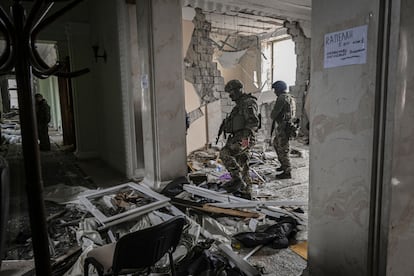Why Russia has failed to secure a quick victory in Ukraine
A shortage of troops, low weapon precision and a rigid chain of command are some of the factors slowing down Moscow’s plan to capture the main cities

Cities have been the seats of power for millennia and their importance has only increased as the world has become more urbanized. As a result, these urban centers have become more significant than ever in times of war. And the Russian offensive in Ukraine is no exception.
When the Russian invasion began, Moscow sought to control Ukraine by going directly to Kyiv, the capital; Kharkiv, the second-largest city in the country; and other important centers. But one month on, Russia has failed to take any significant city, despite its aggressive attacks and the high number of soldiers who have died in combat. The port city of Mariupol is resisting, and in Kyiv, Ukrainian forces have pushed back Russian troops, who are now consolidating their positions instead of advancing.
In response to these setbacks, Russia has resorted to heavy bombardments. Although it announced on Friday that it was changing strategies and focusing on the Donbas region, fighting and attacks continued across the country over the weekend, with even the western city of Lviv targeted.
What is clear is that the Kremlin has not achieved its goal of a quick win in Ukraine. In this analysis, we look at five factors behind this failure.
1. The defenders’ advantage
Military experts agree that in urban warfare it is the defender who has the advantage. The buildings and different structures of a city provide many opportunities to hide and take refuge, especially if there is a subway system, as well as to launch surprise attacks on the enemy.
The attackers, in contrast, have fewer options and in order to penetrate the city, are forced to move through predictable routes such as streets and avenues. It’s such unequal combat that military guides suggest a ratio of 10 offensive soldiers for every defender.
2. Lack of precision
In order to militarily weaken the adversary, precise information on their location and on the fighting is needed. “Russian forces have demonstrated that they are not very competent in this area, as a sign of this they have still not been able to annihilate Ukraine’s anti-aircraft defense,” explains Anthony King, a professor of war studies at the University of Warwick in the United Kingdom. Either Russia does not have good information about their location or their attacks have not been precise. It’s likely to be a mix of these two factors. The Pentagon estimates that Russia still has many missiles in its arsenal, but is seeing shortages in guided missiles.
3. Troop shortages
Another important factor in Russia’s struggle to control major cities is that it simply does not have enough troops. To begin with, many military experts say that the number of soldiers for the invasion – which is estimated to be between 150,000 and 190,000 – is not enough for such a big operation, particularly given the size and population of Ukraine. The strategy of attacking on multiple fronts at once has dispersed the force and led to serious logistical and supply problems. “At no moment have the land forces achieved real supremacy,” says King.
What’s more, as well as being short of troops at the start of the invasion, it’s evident that Russia has also suffered a considerable number of losses, although the exact number is unclear. According to Moscow, the figures stand at 1,300 deaths and 3,800 soldiers injured. The Pentagon, however, believes Russia has lost more than 10% of its force, while NATO believes this number could be even higher.
4. Chain of command
Urban warfare also requires special sophistication when it comes to the chain of command and control. In contemporary military offensives, a wide range of lines of action and technology must be orchestrated. “Western countries, especially the United States, have evolved towards very sophisticated command structures,” explains King. “In Russia, if you look at the Gerasimov doctrine [named after Valery Gerasimov, the chief of staff of Russia’s armed forces], you might imagine that the armed forces had modernized by moving away from the traditional, authoritarian model that is very rigid and top-down. I thought they had moved towards another model. But the last weeks have shown total inefficiency in managing a 21st-century war.”
5. Ukrainian resistance
Ukrainian forces have so far been putting up a strong, agile and effective resistance. Their commitment has not been broken. The supply of Western arms, although limited, is supporting their efforts, as is the flow of information from intelligence agencies and advisories. The Ukrainians have blocked Russia’s advance by blowing up bridges, fighting airborne troops head on, targeting logistical support and courageously resisting within the besieged cities.
The combination of these factors has made it difficult for Russia to take control of Ukraine’s main cities, leading it to turn to long-distance bombardments of civilian cities. The Kremlin’s latest announcement of a new stage may also be seen as recognition that it lacks the capacity to conquer all the cities that it is simultaneously attacking.
Tu suscripción se está usando en otro dispositivo
¿Quieres añadir otro usuario a tu suscripción?
Si continúas leyendo en este dispositivo, no se podrá leer en el otro.
FlechaTu suscripción se está usando en otro dispositivo y solo puedes acceder a EL PAÍS desde un dispositivo a la vez.
Si quieres compartir tu cuenta, cambia tu suscripción a la modalidad Premium, así podrás añadir otro usuario. Cada uno accederá con su propia cuenta de email, lo que os permitirá personalizar vuestra experiencia en EL PAÍS.
¿Tienes una suscripción de empresa? Accede aquí para contratar más cuentas.
En el caso de no saber quién está usando tu cuenta, te recomendamos cambiar tu contraseña aquí.
Si decides continuar compartiendo tu cuenta, este mensaje se mostrará en tu dispositivo y en el de la otra persona que está usando tu cuenta de forma indefinida, afectando a tu experiencia de lectura. Puedes consultar aquí los términos y condiciones de la suscripción digital.
More information
Últimas noticias
Half of Scotland is in the hands of 420 property owners
Pinochet’s victims grapple with José Antonio Kast’s rise in Chile
Reinhard Genzel, Nobel laureate in physics: ‘One-minute videos will never give you the truth’
From digital curfews to blocking apps: How technology experts protect their children online
Most viewed
- Pablo Escobar’s hippos: A serious environmental problem, 40 years on
- Reinhard Genzel, Nobel laureate in physics: ‘One-minute videos will never give you the truth’
- Why we lost the habit of sleeping in two segments and how that changed our sense of time
- Charles Dubouloz, mountaineering star, retires at 36 with a farewell tour inspired by Walter Bonatti
- The Florida Keys tourist paradise is besieged by immigration agents: ‘We’ve never seen anything like this’










































